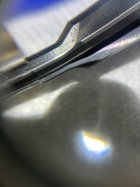I LOVE using JGS twist "core drills"
I just looked for these, didn't know about them
All list as out of stock?
Are they not making them any more because that would be a good idea.
------------------------------------------------
Traditionally some guys would use a roughing reamer
Although when I first began chambering many more experienced people said
"for the low volume guy and the amount of chambers done per year"
Even a roughing reamer isn't necessary
Fully chambering with the finish reamer all the way With no ill effects to the finishing reamer
So I tried it that way and sure enough
no ill effects, my reamers still cut as day one
--------------------------------------------------
For a machinist in the main course of business of doing chambers I would do things a little differently and have more tooling for preboring etc.
But - if you weigh in the added cost of the extra tooling, roughing reamers, prebore drills etc
it's just as easy to get a new reamer as is it to have a roughing reamer also.
I've read of guys doing dozens of chambers on one reamer if its taken care of right
Flutes cleared often enough.... oiled enough etc.
So I took all those old timers advices, and don't get too reamer happy and clear the flutes often so as to not dull or chip any flutes.
---------------------------------------------------
So I could roughing reamer it then finish reamer it
or just finish reamer it and be done, with the mindset if my reamer ever goes dull I'll have to buy another.
---------------------------------------------------
I don't like the idea of predrilling for myself because, the drill has to be held in a chuck by the tailstock
which the tailstock is always a little high (Mine is .003" high) and is never on centerline
so the drill bit will flex, or possibly want to wander
When pushing the finish reamer, it fully floats and keeps itself straight from start to finish
To me, that is just the easiest way for me while buying only the necessary tooling for doing work for oneself
All the Aloris, and carbide and indicators and holders cost enough
I try to keep my tooling costs practical for whats needed without getting too happy about buying stuff I dont REALLY REALLY NEED ya know.
Because I have worked at shops that had all the cool stuff a guy drools over and wants for himself
but...........like I said, I don't machine as my main course of business anymore, just for me.
(I might do one or two for a friend once or twice a year after they shoot mine and want one)
And try to keep it practical as my chambers come out very nice and concentric and follow the bore.
Which in my mind, is the ultimate goal anyway. The targets seem to prove it.
----------------------------------------------------
So am not arguing with you guys that chamber a lot
Just pointing out, for the home hobbyist
.....it can be done nicely and accurately with a piloted finish reamer and some good carbide tooling
I also try to cheat as much as possible to do something cheap and easy
I WANT a Baldor 500, but found I can do the same thing with 20 dollar diamond lapidary discs to sharpen my carbide. Inspect with a Jewelers loupe and touch up or radius with a fine hand held diamond hone.
You'd be surprised what a machinst can do by hand sharpening carbide by eye, I bet many of you guys know what I mean when you have worked with small tolerances for years.
----------------------------------------------------
Close up pic of a 22-250 finish reamer thats done a few chambers and still looks like new












